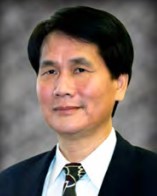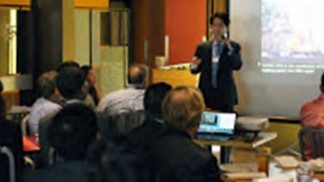Accelerating Yield Improvement By Finding And Eliminating Defects Is The Key To Achieving “More Moore’S” And “More Than Moore”
- 26 Sep 2016
- Volume 8
- NanoScientific Magazine, Fall 2016

VP of Technology and Foundry Operations at NVIDIA
Dr. John Y. Chen, VP of Technology and Foundry Operations at NVIDIA, presented an informative talk about opportunities and challenges for new applications in the semiconductor industry, titled Growing the Semiconductor Industry as Moore's Law Slows Down to a standing room only audience at the Park Systems AFM Semicon West luncheon on July 12, 2016. Dr. Chen discussed how improving yield to levels beyond even today's demanding standards would be the most profound way to grow the industry and advance its technology. His talk explained why nanoscale metrology with modern tools, such as Park AFM, is critical to discover, learn, and eliminate the defects that prevent semiconductor products from becoming viable.
In addition to Dr. Chen’s talk, Dr. Sang-il Park, CEO and Founder of Park Systems, outlined Park’s history of over 2 decades of continuous growth which led to an IPO last December on KOSDAQ, where they recently received the “Best Next Generation Company Award”. NVIDIA has been releasing products with more than double the number of transistors every 1-2 years, exceeding the cadence of Moore’s Law. Its latest GP100 consisting of 15 billion transistors, 50 billion contacts, and 50 billion minimum size vias for the 12 metal layers. This 600 mm2 die, integrated with HBM (High Bandwidth Memory) stacks on a silicon interposer performs at TFLOPS (Tera Floating Operations per Second) levels enabling many graphics and computing applications. Even though Moore’s Law is slowing down, there are still opportunities for “More Moore’s” and there will be “More than Moore”.
Semiconductor products such as GPUs, whichutilizemassive parallel processors, can always usemore transistors for higher performance. Today, Deep Learning, the modern artificial intelligence, is taking off because companies such as NVIDIA can provide powerful super computing engines fueled by “Big Data” in the cloud. NVIDIA’s GPUs are the workhorse brains of the Deep Learning machines which invite the creation of many new applications. While the prices of a single chip from $351 (1971) to $393 (2015) remained much the same, the features on the chip have greatly shrunk, with much more advanced capabilities at reduced costs. The minimum feature size of chips from 1971 to 2015 went from 10 um to 16/14 nm, the transistors per chip increased from few thousands to several billions, and remarkably, the prices of 1,000 transistors went from $150 down to$0.03.
However, going forward with further scaling, the economical benefit can hardly justify the increase cost of wafer manufacturing unless we can improve yield faster and better than ever. Hence, improving yield is the most profound way that we have to extend Moore’s Law. Whether to achieve a state of “More Moore’s” by reaching beyond the 7nm semiconductor fabrication process or “More than Moore” by advancing 3D integration techniques, we can no longer afford product waste due to yield loss. Dice with billions of transistors, GPU/DRAM modules with 3D integration—the yield for these needs to be perfect.The goal must be perfection from 100 billion vias to 10,000 u-bumps with absolutely no defects, even latent ones. Dr. Chen explained that achieving great yield with defectivity at < 1 DPPB (Defective Parts per Billion) level demands essentially perfection in manufacturing. He preached the industry must work together to take the detection and the elimination of defects to the next level.
The key to doing so, Dr. Chen argues, is to adopt nanoscale metrology in earnest, metrology with the ability to image at sub-nanometer resolution, in three-dimensions, and perform at the DPPB level. He encouraged instrumentation vendors such as Park Systems, whose AFM system product line is being continuously refined to meet such stringent requirements.
Dr. Sang-il Park followed Dr. Chen to elaborate on the background of Park Systems and gave the luncheon attendees a walkthrough on the company’s AFM technology and its future plans. "Since Park Systems developed the first commercial AFM in 1989, we have experienced 25 years of continuous growth and product innovation, the longest history of AFM business in the industry," commented Dr. Park, Park Systems Founder and CEO. "We have more than 1,000 Park AFM systems in use in over 30 countries around the world and our future plans include continued expansion into the global AFM market."
Over the years, the ability of Park Systems to consistently outpace the competition with critical technology innovations for semiconductor manufacturing's cutting-edge wafer production has made them a worldleader in Atomic Force Microscopes and nanometrology. At the AFM luncheon, Dr. Sang-il Park highlighted the fast-paced leadership role Park Systems has in nanoscale innovations to improve accuracy and reliability as well as to reduce cost for semiconductor manufacturers.He also spoke on the company’s role as a leading innovator in emerging nanoscale microscopy and metrology technology.
Park recently introduced Park NX20 300 mm, the only AFM on the market capable of scanning the entire sample area of 300mm wafers using a 300mm vacuum chuck while keeping the system noise level below 0.5angstrom (Å) RMS. This achievement will greatly improve production yields and is an example of the company’s efforts to help the semiconductor industry find continued growth and success in the wake of a slowing Moore’s Law.
